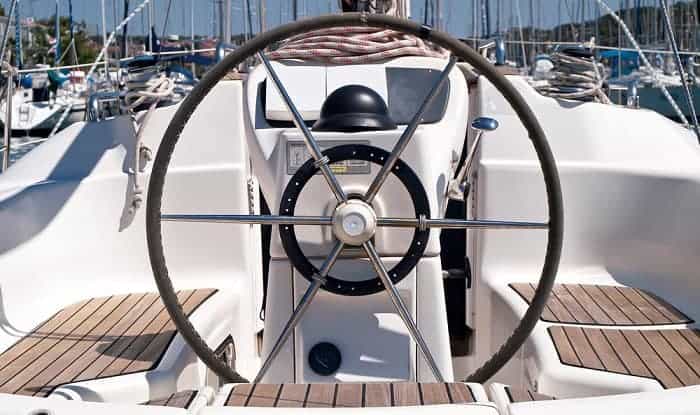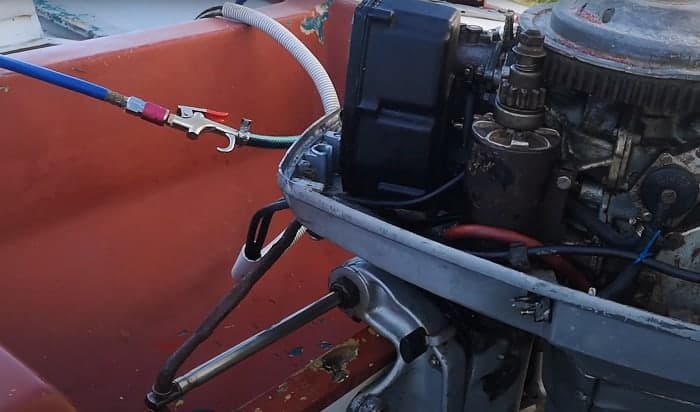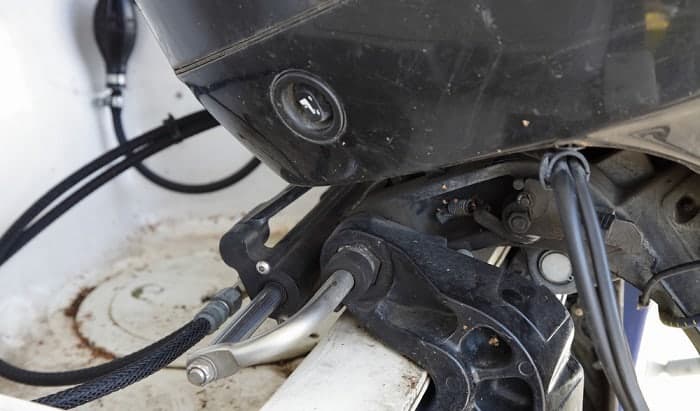If you’ve ever gotten a boat steering cable stuck, and for the life of you, you can’t identify the reason behind it, know that you’re not alone. Many boaters encounter this issue over time, and it’s hard to notice until the cable seizes and locks up completely.
So, how to unfreeze a boat steering cable? Well, in my experience, this mainly depends on what’s causing it to get stuck. If it’s a simple grease issue, applying heat may solve it. Otherwise, dismantle your steering system, degrease, and clean the cable or replace the tube altogether.
Table of Contents
Prepare The Following Tools
If you want to try the heating method, you will need a
- Welding torch
- Grease gun
- A companion to steer the wheel
Should you decide to take the more common route of disassembling and cleaning the tilt tube and steering cable, prepare the following:
- Carburetor cleaner
- Hammer (if necessary to get the tube out)
- Vise grip or wrench
- Welding torch
- Clean rag
- Wire brush
- Razorblade (for dislodging stubborn grease)
The last consideration you can make is to replace the tilt tube or steering cable.
I don’t favor any one of these methods because all of them have given me positive results. I only need to choose one depending on what the problem requires.
Applying Heat To The Tilt Tube
This method doesn’t work all the time. Nonetheless, it doesn’t hurt trying out this method, especially if you want to correct a boat steering cable that’s stiff because of the hardened grease inside the tube. I’ve had many vessels whose steering cables got unfrozen just by doing this.
Do take note that it is rarely a permanent solution. I’ve had many boats that got stuck, and often, it’s because rust has gotten the better of them. If that’s the case, then it’s best to replace the tube and steering cable.
Anyway, this is a straightforward, one-step procedure but will require the assistance of another person. This is how I go about it:
One Person Applies Heat and Grease to the Tube While Another Slowly Turns the Steering Wheel
I apply heat to the tilt tube using a welding torch. The goal is to melt any grease that may have hardened, which is causing the resistance. One person applies the heat and grease simultaneously while another turns the helm left and right. If you see the resistance decreasing as you do this, it’s working as it should.
Again, expect this to work only if your problem is mostly grease-related. If not, then you’ll have no choice but to take the cable out to know why it’s getting stuck.
How to Unfreeze a Boat Steering Cable by Cleaning The Steering Cable And Tilt Tube
If you want a more thorough way of solving stuck steering cables, go with this method. Of course, this is assuming the problem only involves the steering cable or tilt tube being overrun by solidified grease and a bit of rust.
If there’s too much of a rust buildup, you’ll more than likely have to skip this and follow the preventative method in the section that follows. Still, it won’t hurt to see the overall state of your steering cable, so it’s worth doing this if you want to.
Step 1. Take the Steering Cable Out
This step varies a lot in every boat. I’ve had cases where this step took hours but in others, it only lasted for less than an hour. Based on my experience, if you’re having a hard time getting the steering rod out, it’s because of an abundance of rust or grease. In fact, I’m going to lean more towards the latter.
If that’s the case, then you’ll probably only need to clean the steering cable and tilt tube. I’m willing to bet that you’ll have to deal with nuts that are difficult to turn if you’re trying to take the cable. Sometimes, I use kerosene to loosen up the nuts.
The steering cable may require striking its other end with a hammer a couple of times to get it out of the tilt tube completely. You can also try heating up the tube with a welding torch so the grease will soften up, allowing the rod to slide easier.
Again, this depends a lot on the setup in your boat, and this step may take hours because of bad grease and rust accumulations. If I’m replacing the rod, I normally slip a new rod in while using the former as a guide because it saves me time. But if that’s not your intent, then you’ll just have to power through until you finally take the steering cable out.
Step 2. Diagnose the Problem
With the steering cable disconnected, you’ll be able to tell what’s causing the resistance.
You can try turning the helm again. If the cable comes in and out freely and the motor’s pivot tube can turn freely, then the resistance is probably coming from the tilt tube.
If the helm doesn’t turn freely, then it’s because the steering cable has an extreme rust problem that can be hard to address. You may have to replace it if this is the case. The same can be said for pivot tubes that are hard to turn.
But if it’s mostly just solidified grease, as in the case of most stainless steel steering cables, then you can try cleaning it.
Step 3. Clean the Steering Cable’s Rod
Spray a light mist of carburetor cleaner on the rod, particularly on the portions with hardened grease. Wipe the sprayed parts with a clean rag, taking care to dissolve as many, if not all, of the grease mass.
For grease that’s proving to be too stubborn, you can try a more aggressive brush like a wire brush. It’s a perfect choice because it won’t scratch the surface of stainless steel. A couple of times, I’ve even used a razor blade to great success. Aim to take out all the grease.
Step 4. Clean the Tilt Tube
Spray more of the carburetor cleaner in the tilt tube to soften the grease up. One nifty way I go about with this is rolling a small piece of rag with just about a slightly smaller diameter than the tubes.
I drench the rag with a cleaner, put it inside the tube, then push the rag to the other end with another rod or stick that fits. If it’s too hard to push the rag in, you can use a hammer. For a thorough clean, do this step at least three to four times.
Step 5. Regrease the Rod then Put It Back into the Tube
Spray the rod’s entire length with a light coating of lithium grease first. To me, it’s better than most marine-grade oil when preventing accruals.
With that done, you can reinsert the cable. In some cases, this can be done in one smooth pushing action. At other times, you’ll have to find the right angle to work with. I don’t recommend hammering it in. Be patient until the cable is entirely inside the tube.
That’s all! After doing these steps, the helm should noticeably turn more smoothly.
The Best Preventative Approach
To me, the most practical route to take is to prevent the problem from occurring altogether. How? By addressing the most common issues like grease and corrosion buildup. The optimal setup I did for one my vessels with a 40HP Merc is this:
- I installed a new stainless tilt tube to replace the highly corroded one.
- Afterward, I installed a collar with a zerk fitting on the end to make greasing the entire assembly easier.
Until now, I haven’t had to conduct boat steering cable repair on it for close to two years, even with regular use. I tend to do this now on almost all boats, as long as it’s possible because it spares me from going through all the trouble of getting the steering cable out.
Should you need to replace the steering cable, this video is a good point of reference:
Conclusion
Are the techniques I shared to your liking? These methods on how to unfreeze a boat steering cable have never let me down and can work on all types of vessels, especially those with outboard motors. I’m confident one or more will work for you. If you have any questions, feedback, or reaction, just comment below, and I’ll get to you as soon as possible.

“I am James Harvey – founder of Boating Basics Online. It is established with the drive to help out first-time boaters, which are those desiring to explore their way through the water. So if you are new to boating, start from here with me. “



